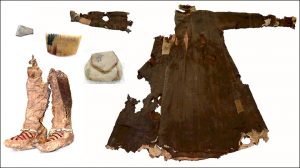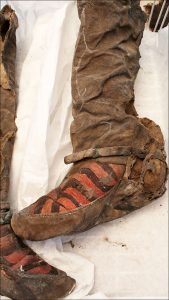After months of research scientists were able to determine the cause of death and details about grave goods found if the grave of an individual buried 1100 years ago, that was discovered last April, in the Altai Mountains of Mongolia.

Remains of a female of Turkik origin, buried around 1100 years ago with a large number of artefacts, has underwent cleaning and conservation, after being discovered last year. Experts now know that she was buried with 51 items such as four changes of clothes, including extraordinary footwear, her sewing kit, a horse and a ram’s head. The female, aged between 30-40 at time of death, suffered a significant head injury, but it is now known if this was the actual cause of the woman’s death sometime in the 10th century. According to the experts, it is quite possible that the traces of a blow of the mummy’s facial bones were the cause of her death.

The grave goods, among which is the intriguing footwear, amazes Mongolian archaeologists and ethnographers, due to high-quality stitches, bright red and black stripes, and the length, that resembles modern footwear. The felt boots are knee length, the soles are leather, and the toecap has stitched stripes in bright red colours. The shoes were dubbed as similar to Adidas shoes with the characteristic stripes at their side.

Within the grave, researchers also discovered a fashionable ancient clutch bag, containing her beauty kit – part of a mirror and a comb – and also a knife. Other find was a saddle with metal stirrups, found in such perfect condition that it could still be used today. Archaeologists state that judging by what was found inside the burial the female was from an ordinary social strata.

Archaeologists believe that it is the first complete Turkik burial in Mongolia, and probably in all Central Asia. It reveals a portion of the beliefs and rituals of Turkiks, such as a sacrifice of a horse, as a mare was deliberately killed and buried near the woman. The horse is believed to be between four and eight years old.


According to the researchers, items found in the grave, namely sewing utensils, point that the woman could have been a seamstress. Experts took 18 samples from the mummy to precisely date it. Results of DNA analysis and radiocarbon dating are still awaited, but other samples date the find to the 10th century AD. The state of preservation of the mummy is due to the high altitude and the body being covered in shilajit, a thick, sticky tar-like substance with the colour ranging from white to dark brown. The mummy is being exhibited in the National Museum of Mongolia.

(after The Center of Cultural Heritage of Mongolia & The Siberian Times)